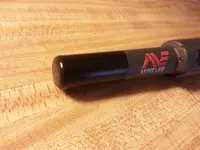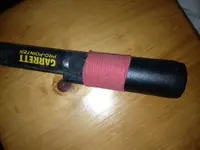You are using an out of date browser. It may not display this or other websites correctly.
You should upgrade or use an alternative browser.
You should upgrade or use an alternative browser.
Garrett Propointer!
- Thread starter scotty544
- Start date
Ace350
Hero Member
- Joined
- Apr 12, 2012
- Messages
- 550
- Reaction score
- 171
- Golden Thread
- 0
- Location
- The Jersey Shore
- Detector(s) used
- Ace350/ATpro/2Excalibur1000's
Eldorado/Bandito II µMax/Conquistador µMax/
Silver Sabre µMax/ Compadre/ Whites TRX & Garrett Pro-Pointer/ Lesche digger model 75 Stealth 720i & S3i Scoops
- Primary Interest:
- All Treasure Hunting
Go on "You Tube" and type in Garrett Pinpointer.
Or Garrett ProPointer tricks.
I'm sure there are plenty of videos to show you all the tips and tricks.
Or Garrett ProPointer tricks.
I'm sure there are plenty of videos to show you all the tips and tricks.
Silver Simon
Hero Member
- Joined
- Mar 17, 2013
- Messages
- 559
- Reaction score
- 350
- Golden Thread
- 0
- Location
- Coldwater Michigan
- Detector(s) used
- XP Deus
- Primary Interest:
- All Treasure Hunting
After reading quiet a few replies on the topic of which pointer to get, I ordered the Garrett Pro last night, are there any tricks to learn on how to use it,or adjust it? I have read some post were people tape a nickel to it or something along those lines
??
I believe that is a trick to increase the range on the pointers. Personally, I don't want a finder with a lot of range. I opted for the Minelab variety, as I liked the adjustable sensitivity. Either way, I recommend getting some Plasti-Dip from Home Depot etc. to help protect the probe end. It has worked wonderfully so far.

scotty544
Hero Member
- #4
Thread Owner
I believe that is a trick to increase the range on the pointers. Personally, I don't want a finder with a lot of range. I opted for the Minelab variety, as I liked the adjustable sensitivity. Either way, I recommend getting some Plasti-Dip from Home Depot etc. to help protect the probe end. It has worked wonderfully so far.
View attachment 765370
Wow that's a cool idea ty!

SusanMN
Silver Member
Cngrats on choosing a great pinpointer. All you need to do is do a quick read of the manual and turn it on, although as others have said, there is a trick to squeeze at bit of extra depth out of it, I Think it's fine as is. The only thing I would point out is that you need to be somewhat careful sliding your Propointer into the holster. If it doesn't seem to go down far enough, give it a slight twist so that the side extension hits the back corner of the holster and it will slip down a few more inches and sit more securely.
scotty544
Hero Member
- #6
Thread Owner
Cngrats on choosing a great pinpointer. All you need to do is do a quick read of the manual and turn it on, although as others have said, there is a trick to squeeze at bit of extra depth out of it, I Think it's fine as is. The only thing I would point out is that you need to be somewhat careful sliding your Propointer into the holster. If it doesn't seem to go down far enough, give it a slight twist so that the side extension hits the back corner of the holster and it will slip down a few more inches and sit more securely.
Good Info TY! Although I just learned its backordered for a week.

olfacere
Full Member
- Joined
- Feb 22, 2013
- Messages
- 154
- Reaction score
- 61
- Golden Thread
- 0
- Location
- Georgia, US
- Detector(s) used
- Tesoro MicroMax Silver
Garrett Pro Pinpointer
- Primary Interest:
- Metal Detecting
The Garrett Pro Pointer is worth the wait. There are two primary "tricks" that can be done with it and both are useful in the field. When the unit starts up (after hitting the power button), it will automatically set its threshold according to its environment. This means that you can hold it next to a piece of metal when you turn it on and it will automatically use an higher threshold (then the unit must be closer to a metallic object before it will respond). This is often mistakenly called "detuning." To reset it, just turn it off and back on normally (away from metal).
You can also double or triple your range and sensitivity with a large piece of metal (coins work, but only provide a small effect). Activate the unit normally, then hold a large, metallic object (like a trowel) against the side of it on the handle. Slowly slide the object toward the business-end of the pointer until it starts to respond to the metal. Then, back the object down the handle until the pointer stops responding. This causes the EM field of the pointer to be magnified by the presence of the conductive metal. It also causes the circuits inside the pointer to run near 100% threshold, meaning that it only takes a tiny signal to make them respond. This can extend your effective detection range with the pointer from 2 inches to 6 inches. Bear in mind that the magnified field will be less stable and can provide some noise that the unit normally wouldn't. It will work, though. This is often mistakenly called "super-tuning."
I say these techniques are mistakenly called "detuning" and "super-tuning" because they have absolutely nothing to do with tuning. In terms of wave characteristics, the pointer is still doing the same thing. I've also heard/read some others who say that these techniques are not reliable enough to use in the field. Bull. Practice a few times (which you will because Pro Pointers are just that fun to play with) and you can easily learn to accurately reproduce the effects whenever and wherever you want. Honestly, I've only used the field-overcharge (super-tuning) technique a few times, but it has come in handy. Exploiting the auto-threshold (detuning) is much more useful. Ever find yourself sifting through a tiny pile, looking for a piece of metal that you can hear, but not see? You can force your pointer to use an higher threshold, meaning less range, so you can use it to pick apart even a tiny pile.
You can also double or triple your range and sensitivity with a large piece of metal (coins work, but only provide a small effect). Activate the unit normally, then hold a large, metallic object (like a trowel) against the side of it on the handle. Slowly slide the object toward the business-end of the pointer until it starts to respond to the metal. Then, back the object down the handle until the pointer stops responding. This causes the EM field of the pointer to be magnified by the presence of the conductive metal. It also causes the circuits inside the pointer to run near 100% threshold, meaning that it only takes a tiny signal to make them respond. This can extend your effective detection range with the pointer from 2 inches to 6 inches. Bear in mind that the magnified field will be less stable and can provide some noise that the unit normally wouldn't. It will work, though. This is often mistakenly called "super-tuning."
I say these techniques are mistakenly called "detuning" and "super-tuning" because they have absolutely nothing to do with tuning. In terms of wave characteristics, the pointer is still doing the same thing. I've also heard/read some others who say that these techniques are not reliable enough to use in the field. Bull. Practice a few times (which you will because Pro Pointers are just that fun to play with) and you can easily learn to accurately reproduce the effects whenever and wherever you want. Honestly, I've only used the field-overcharge (super-tuning) technique a few times, but it has come in handy. Exploiting the auto-threshold (detuning) is much more useful. Ever find yourself sifting through a tiny pile, looking for a piece of metal that you can hear, but not see? You can force your pointer to use an higher threshold, meaning less range, so you can use it to pick apart even a tiny pile.
Last edited:
Wyomingmedic
Sr. Member
- Joined
- Jan 31, 2013
- Messages
- 298
- Reaction score
- 163
- Golden Thread
- 0
- Detector(s) used
- Truffle seeking pig modified for metal.
The results have been so-so
When the pig fails me (which is often), I am relegated to a CTX3030 *sigh*. Like the dark ages or something.
- Primary Interest:
- All Treasure Hunting
Ace350
Hero Member
- Joined
- Apr 12, 2012
- Messages
- 550
- Reaction score
- 171
- Golden Thread
- 0
- Location
- The Jersey Shore
- Detector(s) used
- Ace350/ATpro/2Excalibur1000's
Eldorado/Bandito II µMax/Conquistador µMax/
Silver Sabre µMax/ Compadre/ Whites TRX & Garrett Pro-Pointer/ Lesche digger model 75 Stealth 720i & S3i Scoops
- Primary Interest:
- All Treasure Hunting
I use the supertune method when I don't or can't dig a normal plug. Like when you have permission to hunt someone's property and they have nice grass and you don't want to leave any trace you were digging so you are welcome back. To do it, after I pinpoint the target with my metal detector. I supertune the pinpointer. If it is less than 6" down the Pinpointer will put me right on top of it. It will also give you a good idea on the depth. Then I can dig a very small plug or try to pop it out with a coin probe.
Last edited:
stoney
Jr. Member
I use the "supertuning" method quite a bit. The best method I have found is to simply put a ring on my thumb (I use my wedding ring!) and when I want more sensitivity I slip my grip down the GPP until I hear the tone then just back off a bit. It really does work very well.
I tried the "slide a nickle down the outside of the unit" method but I guess I'm just to clumsy. I kept dropping the nickle...
Stoney
I tried the "slide a nickle down the outside of the unit" method but I guess I'm just to clumsy. I kept dropping the nickle...
Stoney
Similar threads
- Replies
- 1
- Views
- 698
- Suggestion
- Replies
- 2
- Views
- 1K
Users who are viewing this thread
Total: 1 (members: 0, guests: 1)


